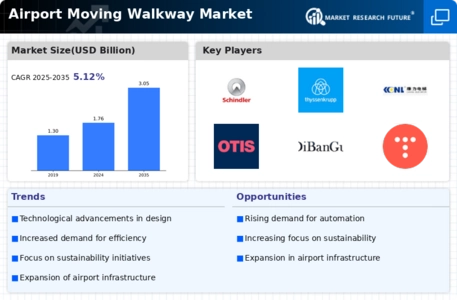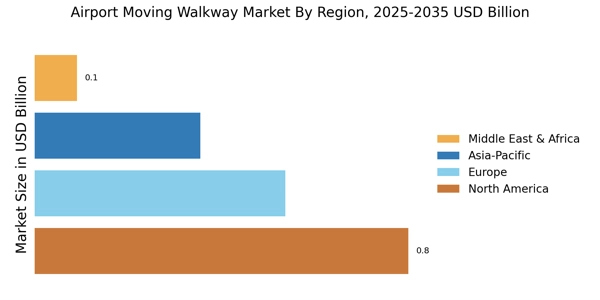Focus on Accessibility
The Airport Moving Walkway Market is increasingly influenced by the emphasis on accessibility for all passengers, including those with reduced mobility. Airports are recognizing the necessity of providing equitable access to facilities, which has led to the integration of moving walkways as a standard feature. This focus on inclusivity aligns with regulatory frameworks that mandate accessibility improvements in public spaces. As a result, airports are investing in moving walkways to ensure that all passengers can navigate terminals with ease. This trend not only enhances the passenger experience but also reflects a broader commitment to social responsibility within the aviation sector.
Technological Innovations
The Airport Moving Walkway Market is significantly shaped by ongoing technological innovations. Advancements in materials, energy efficiency, and automation are transforming the design and functionality of moving walkways. For instance, the introduction of smart walkways equipped with sensors and real-time monitoring systems enhances operational efficiency and safety. Furthermore, the integration of renewable energy sources in walkway systems aligns with sustainability goals, appealing to environmentally conscious travelers. As airports seek to modernize their facilities, the adoption of these innovative technologies is likely to drive growth in the moving walkway market, ensuring that airports remain competitive and efficient.
Increased Air Travel Demand
The Airport Moving Walkway Market is experiencing a surge in demand due to the rising number of air travelers. As more individuals opt for air travel, airports are compelled to enhance their infrastructure to accommodate this influx. According to recent data, air passenger numbers are projected to reach 8.2 billion by 2037, necessitating efficient movement solutions within airports. Moving walkways serve as a vital component in managing passenger flow, reducing congestion, and improving overall airport efficiency. This trend indicates a growing recognition of the importance of seamless passenger experiences, thereby driving investments in moving walkway installations across various airports.
Rising Competition Among Airports
The Airport Moving Walkway Market is influenced by the rising competition among airports to provide superior passenger experiences. As airports strive to differentiate themselves, they are increasingly investing in amenities that enhance convenience and comfort. Moving walkways are recognized as a key feature that can significantly improve passenger flow and reduce travel time within terminals. This competitive landscape encourages airports to adopt innovative solutions, including advanced moving walkway systems, to attract and retain travelers. Consequently, the demand for moving walkways is likely to grow as airports seek to enhance their service offerings and operational efficiency.
Expansion of Airport Infrastructure
The Airport Moving Walkway Market is benefiting from the expansion of airport infrastructure worldwide. Many countries are investing heavily in upgrading and expanding their airport facilities to accommodate increasing passenger volumes. This expansion often includes the construction of new terminals and the renovation of existing ones, where moving walkways are essential for facilitating efficient passenger movement. Recent reports indicate that airport infrastructure investments are expected to exceed 1 trillion by 2030, creating substantial opportunities for moving walkway manufacturers and suppliers. This trend underscores the critical role that moving walkways play in modern airport design and functionality.


















Leave a Comment